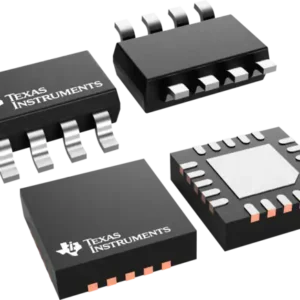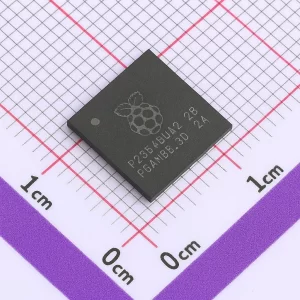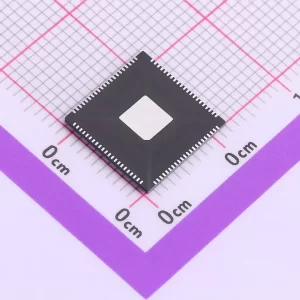MSPM0C1104SDYYR MSPM0C1104SDYYR – Balanced I/O and size: 24-MHz M0+ MCU in SOT-16
- Middle-ground pin count in a slim SOT body—enough I/O for “real” designs without jumping to QFN.
- Family 24-MHz precision oscillator (crystal-less in many cases) for simpler BOM and height.
- Flexible internal VREF (1.4 V / 2.5 V) to match sensor ranges and improve ADC repeatability.
Texas Instruments MSPM0C1104SDYYR Microcontroller (SOT-16) Overview
MSPM0C1104SDYYR hits the sweet spot between ultra-tiny 8-pin parts and larger 20+ pin options. The 16-pin SOT (DYY) package exposes more GPIO and analog channels than 8-lead variants while keeping the low-profile, easy-to-assemble SOT form factor. You get the same 24-MHz Arm® Cortex®-M0+, 16KB Flash / 1KB SRAM, 12-bit ADC up to 1.5 Msps, and the essential UART / I²C (FM+) / SPI—with enough pins to build a “real” front end (multiple sensors, a couple of PWM outputs, and a debug interface) without moving to QFN or VSSOP-20.
Unlike the 8-pin SOT/WSON parts (optimized for minimal I/O) and the VSSOP-20 (optimized for max density), SOT-16 prioritizes balanced pin budget, BOM simplicity, and inspection-friendly leads—great for mixed analog/digital control boards, wall-powered controls, and compact metering accessories.
Highlights (what’s unique about SOT-16)
-
Balanced I/O vs. footprint: More ADC/PWM/serial breakouts than 8-pin packages, yet slimmer and simpler to inspect than QFN/WSON.
-
Leadframe advantages: Gull-wing leads aid AOI/visual inspection, rework, and field repair—useful for lower-volume or serviceable products.
-
Clean mixed-signal routing: Extra pins make it easier to separate analog and high-di/dt nodes, improving 12-bit ADC performance on compact PCBs.
-
Crystal-less by default: Trimmed SYSOSC (~±1.2% with FCL) supports 24-MHz operation without a crystal for most protocols.
-
Battery to mains: Low-power DNA enables battery/energy-harvested nodes; SOT-16 ease-of-use suits wall-powered control boxes, too.
Specifications
| Parameter | Value |
|---|---|
| MCU | Arm Cortex-M0+ @ 24 MHz (SYSOSC ±~1.2% with FCL) |
| Memory | 16KB Flash, 1KB SRAM |
| Analog | 12-bit ADC up to 1.5 Msps; temperature sensor; supply monitor |
| Digital | 3 timers (≤ 14 PWM channels at family level), CRC-16, windowed watchdog, beeper |
| Serial | 1× UART, 1× I²C (FM+), 1× SPI (≤12 Mbps) |
| I/O | Up to 18 GPIO (actual exposed signals package-dependent; SOT-16 offers a practical middle ground) |
| Power / Temp | 1.62–3.6 V; –40 °C to +125 °C; deep-sleep modes supported |
| Package | 16-pin SOT (DYY) – orderable SDYYR |
| Base Product Number | MSPM0C1104 |
Applications
-
Wall-powered smart controls & indicators — front panel keys/LEDs, small relays, opto inputs, plus serial to sensors or modules.
-
Compact e-meters & sub-meter accessories — isolated analog taps, shunt/voltage monitors, and protocol bridging.
-
Small signal-chain controllers — AFE housekeeping (gain/mux control), bias DAC steering, housekeeping telemetry.
-
Multi-sensor pods & utility loggers — I²C/SPI sensor clusters with a few discrete GPIOs for triggers/alerts.
-
Lighting & drivers — multiple PWM channels for LED strings, fan/buzzer control, and basic dimming curves.
Design guidance (differentiated for SOT-16)
-
Partition early: dedicate pins for a primary serial bus (often I²C for sensor farms) and keep UART free during bring-up; SOT-16 gives you room to do both without pin conflicts typical in 8-pin builds.
-
Analog hygiene: place ADC inputs on one side of the MCU if routing allows; give them a quiet return path and keep PWM/CS lines away to reduce kickback.
-
Power integrity: with more I/O switching than an 8-pin design, budget decoupling per rail (0.1 µF close to each VDD pin if exposed) and a small bulk cap nearby.
-
EMI & creepage: gull-wing leads simplify maintaining clearances around high-voltage domains in wall-powered designs; route clocks and SPI centrally to minimize loop area.
-
Debug vs. production: use the extra pins to keep a permanent 3- or 4-pad interface (VCC/GND/UART or SWD). In production, reassign spare pins to LEDs or interrupts with simple firmware conditionals.
Power strategy
-
Event-driven firmware: stay in deep sleep/standby and wake on GPIO/RTC/ADC thresholds.
-
Shelf mode: use shutdown (~200 nA) for shipping/storage.
-
Run current planning: ~87 µA/MHz → about ~2.1 mA at 24 MHz plus peripherals; gate clocks and DMA where available to cut peaks.
Positioning vs. the other packages
-
vs. 8-pin SOT/WSON (SDDFR / SDSGR): more headroom for PWM, multi-sensor ADC, and a dedicated debug port—less pin-mux juggling.
-
vs. 20-pin VSSOP (SDGS20R): smaller body and simpler inspection/rework; you sacrifice some I/O density but keep mixed-signal credibility.
-
vs. QFN-style footprints: easier visual inspection and field service; slightly larger outline but better for low-volume or repairable gear.
Summary
MSPM0C1104SDYYR is the practical middle path in the MSPM0C110x lineup: enough pins to build a clean mixed-signal design with UART/I²C/SPI and multiple ADC/PWM channels, yet still a slim, leaded package that’s easy to assemble, inspect, and service. Perfect when 8-pin is too tight and 20-pin feels like overkill.
Specification: MSPM0C1104SDYYR – Balanced I/O and size: 24-MHz M0+ MCU in SOT-16
|





